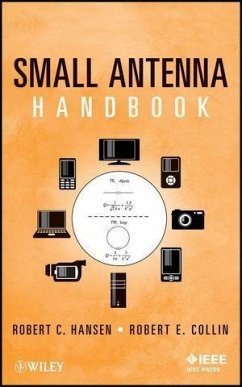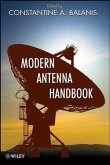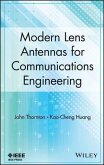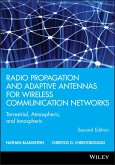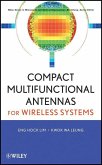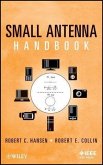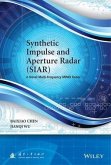

Alle Infos zum eBook verschenken

- Format: ePub
- Merkliste
- Auf die Merkliste
- Bewerten Bewerten
- Teilen
- Produkt teilen
- Produkterinnerung
- Produkterinnerung

Hier können Sie sich einloggen

Bitte loggen Sie sich zunächst in Ihr Kundenkonto ein oder registrieren Sie sich bei bücher.de, um das eBook-Abo tolino select nutzen zu können.
Now in an completely revised, updated, and enlarged Second Edition, Small Antennas in Portable Devices reviews recent significant theoretical and practical developments in the electrically small antenna area. Examining antenna designs that work as well as those that have limitations, this new edition provides practicing engineers and upper level and graduate students with new information on: work on improving bandwidth using spherical helix dipoles; work on electromagnetically coupled structures; exact derivation of the Q for electrically small antennas for both the TE and TM modes; and a new simplified Q formula.…mehr
- Geräte: eReader
- mit Kopierschutz
- eBook Hilfe
- Größe: 13.25MB
![Modern Antenna Handbook (eBook, ePUB) Modern Antenna Handbook (eBook, ePUB)]() Modern Antenna Handbook (eBook, ePUB)220,99 €
Modern Antenna Handbook (eBook, ePUB)220,99 €![Modern Lens Antennas for Communications Engineering (eBook, ePUB) Modern Lens Antennas for Communications Engineering (eBook, ePUB)]() John ThorntonModern Lens Antennas for Communications Engineering (eBook, ePUB)115,99 €
John ThorntonModern Lens Antennas for Communications Engineering (eBook, ePUB)115,99 €![Microstrip and Printed Antennas (eBook, ePUB) Microstrip and Printed Antennas (eBook, ePUB)]() Microstrip and Printed Antennas (eBook, ePUB)116,99 €
Microstrip and Printed Antennas (eBook, ePUB)116,99 €![Radio Propagation and Adaptive Antennas for Wireless Communication Networks (eBook, ePUB) Radio Propagation and Adaptive Antennas for Wireless Communication Networks (eBook, ePUB)]() Nathan BlaunsteinRadio Propagation and Adaptive Antennas for Wireless Communication Networks (eBook, ePUB)159,99 €
Nathan BlaunsteinRadio Propagation and Adaptive Antennas for Wireless Communication Networks (eBook, ePUB)159,99 €![Compact Multifunctional Antennas for Wireless Systems (eBook, ePUB) Compact Multifunctional Antennas for Wireless Systems (eBook, ePUB)]() Eng Hock LimCompact Multifunctional Antennas for Wireless Systems (eBook, ePUB)98,99 €
Eng Hock LimCompact Multifunctional Antennas for Wireless Systems (eBook, ePUB)98,99 €![Small Antenna Handbook (eBook, PDF) Small Antenna Handbook (eBook, PDF)]() Robert C. HansenSmall Antenna Handbook (eBook, PDF)127,99 €
Robert C. HansenSmall Antenna Handbook (eBook, PDF)127,99 €![Synthetic Impulse and Aperture Radar (SIAR) (eBook, ePUB) Synthetic Impulse and Aperture Radar (SIAR) (eBook, ePUB)]() Baixiao ChenSynthetic Impulse and Aperture Radar (SIAR) (eBook, ePUB)139,99 €
Baixiao ChenSynthetic Impulse and Aperture Radar (SIAR) (eBook, ePUB)139,99 €-
-
-
Dieser Download kann aus rechtlichen Gründen nur mit Rechnungsadresse in A, B, BG, CY, CZ, D, DK, EW, E, FIN, F, GR, HR, H, IRL, I, LT, L, LR, M, NL, PL, P, R, S, SLO, SK ausgeliefert werden.
- Produktdetails
- Verlag: John Wiley & Sons
- Seitenzahl: 360
- Erscheinungstermin: 26. August 2011
- Englisch
- ISBN-13: 9781118106853
- Artikelnr.: 37351941
- Verlag: John Wiley & Sons
- Seitenzahl: 360
- Erscheinungstermin: 26. August 2011
- Englisch
- ISBN-13: 9781118106853
- Artikelnr.: 37351941
- Herstellerkennzeichnung Die Herstellerinformationen sind derzeit nicht verfügbar.
1. QUALITY FACTORS OF ESA 1
1.1 Introduction / 1
1.2 Chu Antenna Q / 4
1.3 Collin and Rothschild Q Analysis / 8
1.4 Thal Antenna Q / 14
1.5 Radian Sphere with Mu and/or Epsilon: TE Modes / 16
1.6 Radian Sphere with Mu and/or Epsilon: TM Modes / 22
1.7 Effects of Core Losses / 28
1.8 Q for Spheroidal Enclosures / 34
References / 36
2. BANDWIDTH AND MATCHING 39
2.1 Introduction / 39
2.2 Foster's Reactance Theorem and Smith Chart / 39
2.3 Fano's Matching Limitations / 41
2.4 Matching Circuit Loss Magnification / 46
2.5 Network and Z0 Matching / 48
2.6 Non-Foster Matching Circuits / 50
2.7 Matched and High-Z Preamp Monopoles / 51
2.7.1 A Short Monopole Matched at One Frequency / 52
2.7.2 Short Monopole with High-Impedance Amplifier / 54
References / 55
3. ELECTRICALLY SMALL ANTENNAS: CANONICAL TYPES 59
3.1 Introduction / 59
3.2 Dipole Basic Characteristics / 59
3.2.1 Dipole Impedance and Bandwidth / 59
3.2.2 Resistive and Reactive Loading / 67
3.2.3 Other Loading Configurations / 76
3.2.4 Short Flat Resonant Dipoles / 78
3.2.5 Spherical Helix Antennas / 82
3.2.6 Multiple Resonance Antennas / 84
3.2.6.1 Spherical Dipole; Arc Antennas / 84
3.2.6.2 Multiple Mode Antennas / 86
3.2.6.3 Q Comparisons / 87
3.2.7 Evaluation of Moment Method Codes for Electrically Small Antennas /
88
3.3 Partial Sleeve, PIFA, and Patch / 93
3.3.1 Partial Sleeve / 93
3.3.2 PIFA Designs / 94
3.3.3 Patch with Permeable Substrate / 98
3.4 Loops / 101
3.4.1 Air Core Loops, Single and Multiple Turns / 101
3.4.2 Permeable Core Loops / 107
3.4.3 Receiving Loops / 114
3.4.4 Vector Sensor / 116
3.5 Dielectric Resonator Antennas / 120
References / 127
4. CLEVER PHYSICS, BUT BAD NUMBERS 135
4.1 Contrawound Toroidal Helix Antenna / 135
4.2 Transmission Line Antennas / 138
4.3 Halo, Hula Hoop, and DDRR Antennas / 138
4.4 Dielectric-Loaded Antennas / 140
4.5 Meanderline Antennas / 141
4.6 Cage Monopole / 142
References / 143
5. PATHOLOGICAL ANTENNAS 147
5.1 Crossed-Field Antenna / 147
5.2 Infinite Efficiency Antenna / 149
5.3 E-H Antenna / 150
5.4 TE-TM Antenna / 150
5.5 Crossed Dipoles / 151
5.6 Snyder Dipole / 152
5.7 Loop-Coupled Loop / 155
5.8 Multiarm Dipole / 158
5.9 Complementary Pair Antenna / 158
5.10 Integrated Antenna / 159
5.11 Q ¿ 0 Antenna / 160
5.12 Antenna in a NIM Shell / 161
5.13 Fractal Antennas / 162
5.14 Antenna on a Chip / 170
5.15 Random Segment Antennas / 171
5.16 Multiple Multipoles / 171
5.17 Switched Loop Antennas / 173
5.18 Electrically Small Focal Spots / 174
5.19 ESA Summary / 174
References / 175
6. SUPERDIRECTIVE ANTENNAS 181
6.1 History and Motivation / 181
6.2 Maximum Directivity / 182
6.2.1 Apertures / 182
6.2.2 Arrays / 183
6.2.2.1 Broadside Arrays of Fixed Spacing / 183
6.2.2.2 Endfire Arrays / 186
6.2.2.3 Minimization Codes / 192
6.2.2.4 Resonant Endfire Arrays / 192
6.3 Constrained Superdirectivity / 194
6.3.1 Dolph-Chebyshev Superdirectivity / 194
6.3.2 Superdirective Ratio Constraint / 198
6.3.3 Bandwidth or Q Constraint / 200
6.3.4 Phase or Position Adjustment / 200
6.3.5 Tolerance Constraint / 201
6.4 Bandwidth, Efficiency, and Tolerances / 201
6.4.1 Bandwidth / 201
6.4.2 Efficiency / 205
6.4.3 Tolerances / 208
6.5 Miscellaneous Superdirectivity / 209
6.6 Superdirective Antenna Summary / 210
References / 210
7. SUPERCONDUCTING ANTENNAS 215
7.1 Introduction / 215
7.2 Superconductivity Concepts for Antenna Engineers / 215
7.3 Dipole, Loop, and Patch Antennas / 221
7.3.1 Loop and Dipole Antennas / 222
7.3.2 Microstrip Antennas / 223
7.3.3 Array Antennas / 225
7.3.4 Millimeter-Wave Antennas / 229
7.3.4.1 Waveguide Flat Plane Array / 229
7.3.4.2 Microstrip Planar Array / 230
7.3.5 Submillimeter Antennas / 232
7.3.6 Low-Temperature Superconducting Antennas / 232
7.4 Phasers and Delay Lines / 233
7.5 Superconducting Antenna Summary / 236
References / 236
APPENDIX A A WORLD HISTORY OF ELECTRICALLY SMALL ANTENNAS 243
APPENDIX B DEFINITIONS OF TERMS USEFUL TO ESA 277
APPENDIX C SPHERICAL SHELL OF ENG METAMATERIAL SURROUNDING A DIPOLE ANTENNA
279
APPENDIX D FREQUENCY DISPERSION LIMITS RESOLUTION IN VESELAGO LENS 307
AUTHOR INDEX 335
SUBJECT INDEX 343
1. QUALITY FACTORS OF ESA 1
1.1 Introduction / 1
1.2 Chu Antenna Q / 4
1.3 Collin and Rothschild Q Analysis / 8
1.4 Thal Antenna Q / 14
1.5 Radian Sphere with Mu and/or Epsilon: TE Modes / 16
1.6 Radian Sphere with Mu and/or Epsilon: TM Modes / 22
1.7 Effects of Core Losses / 28
1.8 Q for Spheroidal Enclosures / 34
References / 36
2. BANDWIDTH AND MATCHING 39
2.1 Introduction / 39
2.2 Foster's Reactance Theorem and Smith Chart / 39
2.3 Fano's Matching Limitations / 41
2.4 Matching Circuit Loss Magnification / 46
2.5 Network and Z0 Matching / 48
2.6 Non-Foster Matching Circuits / 50
2.7 Matched and High-Z Preamp Monopoles / 51
2.7.1 A Short Monopole Matched at One Frequency / 52
2.7.2 Short Monopole with High-Impedance Amplifier / 54
References / 55
3. ELECTRICALLY SMALL ANTENNAS: CANONICAL TYPES 59
3.1 Introduction / 59
3.2 Dipole Basic Characteristics / 59
3.2.1 Dipole Impedance and Bandwidth / 59
3.2.2 Resistive and Reactive Loading / 67
3.2.3 Other Loading Configurations / 76
3.2.4 Short Flat Resonant Dipoles / 78
3.2.5 Spherical Helix Antennas / 82
3.2.6 Multiple Resonance Antennas / 84
3.2.6.1 Spherical Dipole; Arc Antennas / 84
3.2.6.2 Multiple Mode Antennas / 86
3.2.6.3 Q Comparisons / 87
3.2.7 Evaluation of Moment Method Codes for Electrically Small Antennas /
88
3.3 Partial Sleeve, PIFA, and Patch / 93
3.3.1 Partial Sleeve / 93
3.3.2 PIFA Designs / 94
3.3.3 Patch with Permeable Substrate / 98
3.4 Loops / 101
3.4.1 Air Core Loops, Single and Multiple Turns / 101
3.4.2 Permeable Core Loops / 107
3.4.3 Receiving Loops / 114
3.4.4 Vector Sensor / 116
3.5 Dielectric Resonator Antennas / 120
References / 127
4. CLEVER PHYSICS, BUT BAD NUMBERS 135
4.1 Contrawound Toroidal Helix Antenna / 135
4.2 Transmission Line Antennas / 138
4.3 Halo, Hula Hoop, and DDRR Antennas / 138
4.4 Dielectric-Loaded Antennas / 140
4.5 Meanderline Antennas / 141
4.6 Cage Monopole / 142
References / 143
5. PATHOLOGICAL ANTENNAS 147
5.1 Crossed-Field Antenna / 147
5.2 Infinite Efficiency Antenna / 149
5.3 E-H Antenna / 150
5.4 TE-TM Antenna / 150
5.5 Crossed Dipoles / 151
5.6 Snyder Dipole / 152
5.7 Loop-Coupled Loop / 155
5.8 Multiarm Dipole / 158
5.9 Complementary Pair Antenna / 158
5.10 Integrated Antenna / 159
5.11 Q ¿ 0 Antenna / 160
5.12 Antenna in a NIM Shell / 161
5.13 Fractal Antennas / 162
5.14 Antenna on a Chip / 170
5.15 Random Segment Antennas / 171
5.16 Multiple Multipoles / 171
5.17 Switched Loop Antennas / 173
5.18 Electrically Small Focal Spots / 174
5.19 ESA Summary / 174
References / 175
6. SUPERDIRECTIVE ANTENNAS 181
6.1 History and Motivation / 181
6.2 Maximum Directivity / 182
6.2.1 Apertures / 182
6.2.2 Arrays / 183
6.2.2.1 Broadside Arrays of Fixed Spacing / 183
6.2.2.2 Endfire Arrays / 186
6.2.2.3 Minimization Codes / 192
6.2.2.4 Resonant Endfire Arrays / 192
6.3 Constrained Superdirectivity / 194
6.3.1 Dolph-Chebyshev Superdirectivity / 194
6.3.2 Superdirective Ratio Constraint / 198
6.3.3 Bandwidth or Q Constraint / 200
6.3.4 Phase or Position Adjustment / 200
6.3.5 Tolerance Constraint / 201
6.4 Bandwidth, Efficiency, and Tolerances / 201
6.4.1 Bandwidth / 201
6.4.2 Efficiency / 205
6.4.3 Tolerances / 208
6.5 Miscellaneous Superdirectivity / 209
6.6 Superdirective Antenna Summary / 210
References / 210
7. SUPERCONDUCTING ANTENNAS 215
7.1 Introduction / 215
7.2 Superconductivity Concepts for Antenna Engineers / 215
7.3 Dipole, Loop, and Patch Antennas / 221
7.3.1 Loop and Dipole Antennas / 222
7.3.2 Microstrip Antennas / 223
7.3.3 Array Antennas / 225
7.3.4 Millimeter-Wave Antennas / 229
7.3.4.1 Waveguide Flat Plane Array / 229
7.3.4.2 Microstrip Planar Array / 230
7.3.5 Submillimeter Antennas / 232
7.3.6 Low-Temperature Superconducting Antennas / 232
7.4 Phasers and Delay Lines / 233
7.5 Superconducting Antenna Summary / 236
References / 236
APPENDIX A A WORLD HISTORY OF ELECTRICALLY SMALL ANTENNAS 243
APPENDIX B DEFINITIONS OF TERMS USEFUL TO ESA 277
APPENDIX C SPHERICAL SHELL OF ENG METAMATERIAL SURROUNDING A DIPOLE ANTENNA
279
APPENDIX D FREQUENCY DISPERSION LIMITS RESOLUTION IN VESELAGO LENS 307
AUTHOR INDEX 335
SUBJECT INDEX 343
